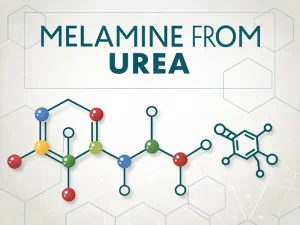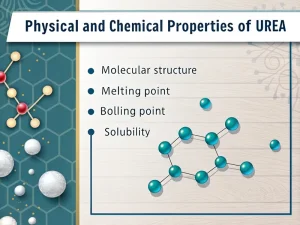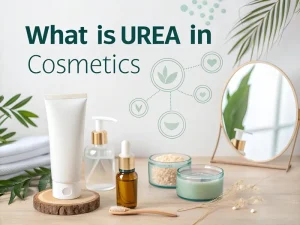
Melamine From Urea
Tech Blog melamine from urea Melamine is well-known for its wide range of applications, but its raw material for production is surprisingly urea. For manufacturers,

When browsing the ingredient lists of moisturizers, body lotions, or foot care products, you may come across a familiar name: urea. Perhaps your understanding of urea is still limited to fertilizer scenarios or human metabolic processes, and you may wonder why it appears in beauty products, leading to a direct question: “What exactly is urea in cosmetics? Is it what I was thinking?”
Firstly, let’s dispel the biggest misconception: no, the urea used in cosmetics and skincare products is definitely not derived from animal or human urine.
The urea used in skincare products is synthetic, produced through strictly controlled chemical reactions in a laboratory. It has extremely high purity, is very safe, and is among the most effective and extensively researched ingredients in skincare.
Now, let’s delve into why this seemingly strange ingredient is actually the “superhero” of your skin.
This synthetic urea has a chemical structure identical to that of urea produced by the skin, making it highly compatible with human tissues.
In the outermost stratum corneum of the skin, urea is already a component of the “natural moisturizing factor (NMF)” – a group of compounds that can lock in moisture and keep the skin soft. When urea is added to cosmetics, it further enhances this natural moisturizing function and becomes an ideal ingredient for dry, rough, or problematic skin.
The effectiveness of urea in skincare stems from three core mechanisms of action that work together to improve skin health:
As a moisturizer, urea can extract moisture from two sources: the surrounding air and deep layers of the skin. It forms hydrogen bonds with water molecules, firmly locking water in the stratum corneum, making the skin feel full and smooth and reducing dryness. Unlike some moisturizers, such as glycerin, urea can be effective even in dry climates and is an excellent choice for winter skincare.
Improving rough calluses: Hand and foot creams containing urea can break down hard calluses and restore smoothness to the skin. It is particularly practical for people who need to stand for a long time or wear tight shoes.
Urea can soften the “adhesive” (called desmosomes) that connects dead skin cells, promoting the natural shedding of ageing keratin. This is different from physical exfoliating products, such as exfoliating creams, or powerful chemical exfoliating products, such as high-concentration fruit acids. The exfoliating effect of urea is mild yet effective, making it suitable for sensitive or eczema-prone skin.
Urea helps repair damaged skin barriers by replenishing moisture and removing dead skin cells. A healthy skin barrier can block the entry of external stimuli while locking in internal humidity, reducing the risk of redness, sensitivity, and infection, which is particularly important for dry or damaged skin.
Relieve dryness and dandruff: This is the most well-known effect of urea. It is a powerful tool for reducing dryness on the elbows, knees, and heels. It can penetrate thickened skin and achieve deep softening and moisturization. For severe dryness (such as dry skin disease), dermatologists often recommend a urea-containing face cream.
Assist in improving eczema and psoriasis: Eczema and psoriasis can cause dry, itchy, and flaky skin. The moisturizing and exfoliating effects of urea can reduce scales, relieve itching, and repair the skin barrier. Many prescription-grade products targeting such issues contain urea.
The concentration of urea in cosmetics directly determines its efficacy and applicable scenarios, with a common concentration range of 2% to 40%. You can choose according to your own needs:
Concentration | Best For | Common Products |
|---|---|---|
2% – 10% | Normal to dry skin, daily hydration, mild exfoliation | Face moisturizers, body lotions, serums |
10% – 20% | Very dry skin, rough patches, mild eczema/psoriasis | Body butters, foot creams, targeted spot treatments |
20% – 40% | Severe dryness, thick calluses, moderate to severe eczema/psoriasis | Prescription or clinical-grade creams, foot peels |
Urea in cosmetics is a naturally derived and synthetically produced skincare ingredient that moisturizes, exfoliates, and helps repair skin barriers. It is a highly cost-effective choice in various skincare processes. Whether you have dry skin, eczema, or want to improve calluses and enhance skin hydration, urea can help.

Tech Blog melamine from urea Melamine is well-known for its wide range of applications, but its raw material for production is surprisingly urea. For manufacturers,

Tech Blog physical and chemical properties of urea Urea, with the chemical formula CO(NH2)2, is a simple organic compound that plays a central role in

Tech Blog what is urea in cosmetics? When browsing the ingredient lists of moisturizers, body lotions, or foot care products, you may come across a

JINGJIANG MELAMINE POWDER
© JINJIANG MELAMINE